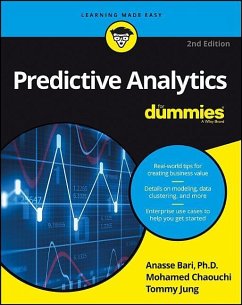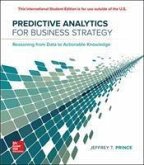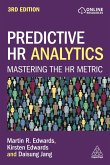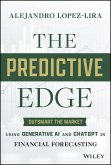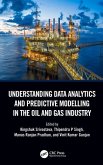- Broschiertes Buch
- Merkliste
- Auf die Merkliste
- Bewerten Bewerten
- Teilen
- Produkt teilen
- Produkterinnerung
- Produkterinnerung
Use Big Data and technology to uncover real-world insights You don't need a time machine to predict the future. All it takes is a little knowledge and know-how, and Predictive Analytics For Dummies gets you there fast.
Andere Kunden interessierten sich auch für
![Boolean Networks as Predictive Models of Emergent Biological Behaviors Boolean Networks as Predictive Models of Emergent Biological Behaviors]() Jordan C. Rozum (State University of New Yor Binghamton UniversityBoolean Networks as Predictive Models of Emergent Biological Behaviors24,99 €
Jordan C. Rozum (State University of New Yor Binghamton UniversityBoolean Networks as Predictive Models of Emergent Biological Behaviors24,99 €![ISE Predictive Analytics for Business Strategy ISE Predictive Analytics for Business Strategy]() Jeff PrinceISE Predictive Analytics for Business Strategy81,99 €
Jeff PrinceISE Predictive Analytics for Business Strategy81,99 €![Predictive HR Analytics Predictive HR Analytics]() Dr Martin EdwardsPredictive HR Analytics38,99 €
Dr Martin EdwardsPredictive HR Analytics38,99 €![Model Predictive Control of High Power Converters and Industrial Drives Model Predictive Control of High Power Converters and Industrial Drives]() Tobias GeyerModel Predictive Control of High Power Converters and Industrial Drives154,99 €
Tobias GeyerModel Predictive Control of High Power Converters and Industrial Drives154,99 €![The Predictive Edge The Predictive Edge]() Alejandro Lopez-Lira (University of Florida)The Predictive Edge34,99 €
Alejandro Lopez-Lira (University of Florida)The Predictive Edge34,99 €![Complete Guide to Preventive and Predictive Maintenance Complete Guide to Preventive and Predictive Maintenance]() Joel LevittComplete Guide to Preventive and Predictive Maintenance104,99 €
Joel LevittComplete Guide to Preventive and Predictive Maintenance104,99 €![Understanding Data Analytics and Predictive Modelling in the Oil and Gas Industry Understanding Data Analytics and Predictive Modelling in the Oil and Gas Industry]() Understanding Data Analytics and Predictive Modelling in the Oil and Gas Industry136,99 €
Understanding Data Analytics and Predictive Modelling in the Oil and Gas Industry136,99 €-
-
-
Use Big Data and technology to uncover real-world insights You don't need a time machine to predict the future. All it takes is a little knowledge and know-how, and Predictive Analytics For Dummies gets you there fast.
Hinweis: Dieser Artikel kann nur an eine deutsche Lieferadresse ausgeliefert werden.
Hinweis: Dieser Artikel kann nur an eine deutsche Lieferadresse ausgeliefert werden.
Produktdetails
- Produktdetails
- Verlag: John Wiley & Sons Inc
- 2 ed
- Seitenzahl: 464
- Erscheinungstermin: 9. Dezember 2016
- Englisch
- Abmessung: 233mm x 187mm x 27mm
- Gewicht: 820g
- ISBN-13: 9781119267003
- ISBN-10: 1119267005
- Artikelnr.: 44385110
- Herstellerkennzeichnung
- Libri GmbH
- Europaallee 1
- 36244 Bad Hersfeld
- gpsr@libri.de
- Verlag: John Wiley & Sons Inc
- 2 ed
- Seitenzahl: 464
- Erscheinungstermin: 9. Dezember 2016
- Englisch
- Abmessung: 233mm x 187mm x 27mm
- Gewicht: 820g
- ISBN-13: 9781119267003
- ISBN-10: 1119267005
- Artikelnr.: 44385110
- Herstellerkennzeichnung
- Libri GmbH
- Europaallee 1
- 36244 Bad Hersfeld
- gpsr@libri.de
Anasse Bari, Ph.D. is data science expert and a university professor who has many years of predictive modeling and data analytics experience. Mohamed Chaouchi is a veteran software engineer who has conducted extensive research using data mining methods. Tommy Jung is a software engineer with expertise in enterprise web applications and analytics.
INTRODUCTION 1
PART 1: GETTING STARTED WITH PREDICTIVE ANALYTICS 5
CHAPTER 1: Entering the Arena 7
Exploring Predictive Analytics 7
Mining data 8
Highlighting the model 9
Adding Business Value 10
Endless opportunities 11
Empowering your organization 12
Starting a Predictive Analytic Project 13
Business knowledge 14
Data-science team and technology 15
The Data 16
Ongoing Predictive Analytics 17
Forming Your Predictive Analytics Team 18
Hiring experienced practitioners 18
Demonstrating commitment and curiosity 19
Surveying the Marketplace 19
Responding to big data 20
Working with big data 20
CHAPTER 2: Predictive Analytics in the Wild 23
Online Marketing and Retail 25
Recommender systems 25
Personalized shopping on the Internet 26
Implementing a Recommender System 28
Collaborative filtering 28
Content-based filtering 36
Hybrid recommender systems 39
Target Marketing 41
Targeting using predictive modeling 42
Uplift modeling 43
Personalization 46
Online customer experience 46
Retargeting 47
Implementation 47
Optimizing using personalization 48
Similarities of Personalization and Recommendations 48
Content and Text Analytics 50
CHAPTER 3: Exploring Your Data Types and Associated Techniques 51
Recognizing Your Data Types 52
Structured and unstructured data 52
Static and streamed data 56
Identifying Data Categories 58
Attitudinal data 59
Behavioral data 60
Demographic data 61
Generating Predictive Analytics 61
Data-driven analytics 62
User-driven analytics 64
Connecting to Related Disciplines 65
Statistics 65
Data mining 66
Machine learning 67
CHAPTER 4: Complexities of Data 69
Finding Value in Your Data 70
Delving into your data 70
Data validity 70
Data variety 71
Constantly Changing Data 72
Data velocity 72
High volume of data 73
Complexities in Searching Your Data 73
Keyword-based search 74
Semantic-based search 74
Contextual search 76
Differentiating Business Intelligence from Big-Data Analytics 79
Exploration of Raw Data 80
Identifying data attributes 80
Exploring common data visualizations 81
Tabular visualizations 81
Word clouds 82
Flocking birds as a novel data representation 83
Graph charts 85
Common visualizations 87
PART 2: INCORPORATING ALGORITHMS IN YOUR MODELS 89
CHAPTER 5: Applying Models 91
Modeling Data 92
Models and simulation 92
Categorizing models 94
Describing and summarizing data 96
Making better business decisions 97
Healthcare Analytics Case Studies 97
Google Flu Trends 97
Cancer survivability predictors 99
Social and Marketing Analytics Case Studies 101
Target store predicts pregnant women 101
Twitter-based predictors of earthquakes 102
Twitter-based predictors of political campaign outcomes 103
Tweets as predictors for the stock market 105
Predicting variation of stock prices from news articles 106
Analyzing New York City's bicycle usage 107
Predictions and responses 110
Data compression 111
Prognostics and its Relation to Predictive Analytics 112
The Rise of Open Data 113
CHAPTER 6: Identifying Similarities in Data 115
Explaining Data Clustering 116
Converting Raw Data into a Matrix 120
Creating a matrix of terms in documents 120
Term selection 121
Identifying Groups in Your Data 122
K-means clustering algorithm 122
Clustering by nearest neighbors 126
Density-based algorithms 130
Finding Associations in Data Items 132
Applying Biologically Inspired Clustering Techniques 136
Birds flocking: Flock by Leader algorithm 136
Ant colonies 143
CHAPTER 7: Predicting the Future Using Data Classification 147
Explaining Data Classification 149
Introducing Data Classification to Your Business 152
Exploring the Data-Classification Process 154
Using Data Classification to Predict the Future 156
Decision trees 156
Algorithms for Generating Decision Trees 159
Support vector machine 163
Ensemble Methods to Boost Prediction Accuracy 165
Naïve Bayes classification algorithm 166
The Markov Model 172
Linear regression 177
Neural networks 177
Deep Learning 179
PART 3: DEVELOPING A ROADMAP 185
CHAPTER 8: Convincing Your Management to Adopt Predictive Analytics 187
Making the Business Case 188
Gathering Support from Stakeholders 195
Presenting Your Proposal 206
CHAPTER 9: Preparing Data 209
Listing the Business Objectives 210
Processing Your Data 212
Identifying the data 212
Cleaning the data 213
Generating any derived data 215
Reducing the dimensionality of your data 215
Applying principal component analysis 216
Leveraging singular value decomposition 218
Working with Features 219
Structuring Your Data 224
Extracting, transforming and loading your data 225
Keeping the data up to date 226
Outlining testing and test data 226
CHAPTER 10: Building a Predictive Model 229
Getting Started 230
Defining your business objectives 232
Preparing your data 233
Choosing an algorithm 236
Developing and Testing the Model 237
Going Live with the Model 242
CHAPTER 11: Visualization of Analytical Results 245
Visualization as a Predictive Tool 246
Evaluating Your Visualization 249
Visualizing Your Model's Analytical Results 251
Visualizing hidden groupings in your data 251
Visualizing data classification results 252
Visualizing outliers in your data 254
Visualization of Decision Trees 254
Visualizing predictions 256
Novel Visualization in Predictive Analytics 258
Big Data Visualization Tools 262
Tableau 263
Google Charts 263
Plotly 263
Infogram 264
PART 4: PROGRAMMING PREDICTIVE ANALYTICS 265
CHAPTER 12: Creating Basic Prediction Examples 267
Installing the Software Packages 268
Installing Python 268
Installing the machine-learning module 270
Installing the dependencies 274
Preparing the Data 278
Making Predictions Using Classification Algorithms 280
Creating a supervised learning model with SVM 281
Creating a supervised learning model with logistic regression 288
Creating a supervised learning model with random forest 295
Comparing the classification models 297
CHAPTER 13: Creating Basic Examples of Unsupervised Predictions 299
Getting the Sample Dataset 300
Using Clustering Algorithms to Make Predictions 301
Comparing clustering models 301
Creating an unsupervised learning model with K-means 302
Creating an unsupervised learning model with DBSCAN 314
Creating an unsupervised learning model with mean shift 318
CHAPTER 14: Predictive Modeling with R 323
Programming in R 325
Installing R 325
Installing RStudio 326
Getting familiar with the environment 327
Learning just a bit of R 328
Making Predictions Using R 334
Predicting using regression 334
Using classification to predict 345
Classification by random forest 354
CHAPTER 15: Avoiding Analysis Traps 359
Data Challenges 360
Outlining the limitations of the data 361
Dealing with extreme cases (outliers) 364
Data smoothing 367
Curve fitting 371
Keeping the assumptions to a minimum 374
Analysis Challenges 375
PART 5: EXECUTING BIG DATA 381
CHAPTER 16: Targeting Big Data 383
Major Technological Trends in Predictive Analytics 384
Exploring predictive analytics as a service 384
Aggregating distributed data for analysis 385
Real-time data-driven analytics 387
Applying Open-Source Tools to Big Data 388
Apache Hadoop 388
Apache Spark 394
CHAPTER 17: Getting Ready for Enterprise Analytics 399
Analytics as a Service 403
Google Analytics 403
IBM Watson 405
Microsoft Revolution R Enterprise 405
Preparing for a Proof-of-Value of Predictive Analytics Prototype 406
Prototyping for predictive analytics 406
Testing your predictive analytics model 409
PART 6: THE PART OF TENS 411
CHAPTER 18: Ten Reasons to Implement
Predictive Analytics 413
CHAPTER 19: Ten Steps to Build a Predictive Analytic Model 423
INDEX 433
PART 1: GETTING STARTED WITH PREDICTIVE ANALYTICS 5
CHAPTER 1: Entering the Arena 7
Exploring Predictive Analytics 7
Mining data 8
Highlighting the model 9
Adding Business Value 10
Endless opportunities 11
Empowering your organization 12
Starting a Predictive Analytic Project 13
Business knowledge 14
Data-science team and technology 15
The Data 16
Ongoing Predictive Analytics 17
Forming Your Predictive Analytics Team 18
Hiring experienced practitioners 18
Demonstrating commitment and curiosity 19
Surveying the Marketplace 19
Responding to big data 20
Working with big data 20
CHAPTER 2: Predictive Analytics in the Wild 23
Online Marketing and Retail 25
Recommender systems 25
Personalized shopping on the Internet 26
Implementing a Recommender System 28
Collaborative filtering 28
Content-based filtering 36
Hybrid recommender systems 39
Target Marketing 41
Targeting using predictive modeling 42
Uplift modeling 43
Personalization 46
Online customer experience 46
Retargeting 47
Implementation 47
Optimizing using personalization 48
Similarities of Personalization and Recommendations 48
Content and Text Analytics 50
CHAPTER 3: Exploring Your Data Types and Associated Techniques 51
Recognizing Your Data Types 52
Structured and unstructured data 52
Static and streamed data 56
Identifying Data Categories 58
Attitudinal data 59
Behavioral data 60
Demographic data 61
Generating Predictive Analytics 61
Data-driven analytics 62
User-driven analytics 64
Connecting to Related Disciplines 65
Statistics 65
Data mining 66
Machine learning 67
CHAPTER 4: Complexities of Data 69
Finding Value in Your Data 70
Delving into your data 70
Data validity 70
Data variety 71
Constantly Changing Data 72
Data velocity 72
High volume of data 73
Complexities in Searching Your Data 73
Keyword-based search 74
Semantic-based search 74
Contextual search 76
Differentiating Business Intelligence from Big-Data Analytics 79
Exploration of Raw Data 80
Identifying data attributes 80
Exploring common data visualizations 81
Tabular visualizations 81
Word clouds 82
Flocking birds as a novel data representation 83
Graph charts 85
Common visualizations 87
PART 2: INCORPORATING ALGORITHMS IN YOUR MODELS 89
CHAPTER 5: Applying Models 91
Modeling Data 92
Models and simulation 92
Categorizing models 94
Describing and summarizing data 96
Making better business decisions 97
Healthcare Analytics Case Studies 97
Google Flu Trends 97
Cancer survivability predictors 99
Social and Marketing Analytics Case Studies 101
Target store predicts pregnant women 101
Twitter-based predictors of earthquakes 102
Twitter-based predictors of political campaign outcomes 103
Tweets as predictors for the stock market 105
Predicting variation of stock prices from news articles 106
Analyzing New York City's bicycle usage 107
Predictions and responses 110
Data compression 111
Prognostics and its Relation to Predictive Analytics 112
The Rise of Open Data 113
CHAPTER 6: Identifying Similarities in Data 115
Explaining Data Clustering 116
Converting Raw Data into a Matrix 120
Creating a matrix of terms in documents 120
Term selection 121
Identifying Groups in Your Data 122
K-means clustering algorithm 122
Clustering by nearest neighbors 126
Density-based algorithms 130
Finding Associations in Data Items 132
Applying Biologically Inspired Clustering Techniques 136
Birds flocking: Flock by Leader algorithm 136
Ant colonies 143
CHAPTER 7: Predicting the Future Using Data Classification 147
Explaining Data Classification 149
Introducing Data Classification to Your Business 152
Exploring the Data-Classification Process 154
Using Data Classification to Predict the Future 156
Decision trees 156
Algorithms for Generating Decision Trees 159
Support vector machine 163
Ensemble Methods to Boost Prediction Accuracy 165
Naïve Bayes classification algorithm 166
The Markov Model 172
Linear regression 177
Neural networks 177
Deep Learning 179
PART 3: DEVELOPING A ROADMAP 185
CHAPTER 8: Convincing Your Management to Adopt Predictive Analytics 187
Making the Business Case 188
Gathering Support from Stakeholders 195
Presenting Your Proposal 206
CHAPTER 9: Preparing Data 209
Listing the Business Objectives 210
Processing Your Data 212
Identifying the data 212
Cleaning the data 213
Generating any derived data 215
Reducing the dimensionality of your data 215
Applying principal component analysis 216
Leveraging singular value decomposition 218
Working with Features 219
Structuring Your Data 224
Extracting, transforming and loading your data 225
Keeping the data up to date 226
Outlining testing and test data 226
CHAPTER 10: Building a Predictive Model 229
Getting Started 230
Defining your business objectives 232
Preparing your data 233
Choosing an algorithm 236
Developing and Testing the Model 237
Going Live with the Model 242
CHAPTER 11: Visualization of Analytical Results 245
Visualization as a Predictive Tool 246
Evaluating Your Visualization 249
Visualizing Your Model's Analytical Results 251
Visualizing hidden groupings in your data 251
Visualizing data classification results 252
Visualizing outliers in your data 254
Visualization of Decision Trees 254
Visualizing predictions 256
Novel Visualization in Predictive Analytics 258
Big Data Visualization Tools 262
Tableau 263
Google Charts 263
Plotly 263
Infogram 264
PART 4: PROGRAMMING PREDICTIVE ANALYTICS 265
CHAPTER 12: Creating Basic Prediction Examples 267
Installing the Software Packages 268
Installing Python 268
Installing the machine-learning module 270
Installing the dependencies 274
Preparing the Data 278
Making Predictions Using Classification Algorithms 280
Creating a supervised learning model with SVM 281
Creating a supervised learning model with logistic regression 288
Creating a supervised learning model with random forest 295
Comparing the classification models 297
CHAPTER 13: Creating Basic Examples of Unsupervised Predictions 299
Getting the Sample Dataset 300
Using Clustering Algorithms to Make Predictions 301
Comparing clustering models 301
Creating an unsupervised learning model with K-means 302
Creating an unsupervised learning model with DBSCAN 314
Creating an unsupervised learning model with mean shift 318
CHAPTER 14: Predictive Modeling with R 323
Programming in R 325
Installing R 325
Installing RStudio 326
Getting familiar with the environment 327
Learning just a bit of R 328
Making Predictions Using R 334
Predicting using regression 334
Using classification to predict 345
Classification by random forest 354
CHAPTER 15: Avoiding Analysis Traps 359
Data Challenges 360
Outlining the limitations of the data 361
Dealing with extreme cases (outliers) 364
Data smoothing 367
Curve fitting 371
Keeping the assumptions to a minimum 374
Analysis Challenges 375
PART 5: EXECUTING BIG DATA 381
CHAPTER 16: Targeting Big Data 383
Major Technological Trends in Predictive Analytics 384
Exploring predictive analytics as a service 384
Aggregating distributed data for analysis 385
Real-time data-driven analytics 387
Applying Open-Source Tools to Big Data 388
Apache Hadoop 388
Apache Spark 394
CHAPTER 17: Getting Ready for Enterprise Analytics 399
Analytics as a Service 403
Google Analytics 403
IBM Watson 405
Microsoft Revolution R Enterprise 405
Preparing for a Proof-of-Value of Predictive Analytics Prototype 406
Prototyping for predictive analytics 406
Testing your predictive analytics model 409
PART 6: THE PART OF TENS 411
CHAPTER 18: Ten Reasons to Implement
Predictive Analytics 413
CHAPTER 19: Ten Steps to Build a Predictive Analytic Model 423
INDEX 433
INTRODUCTION 1
PART 1: GETTING STARTED WITH PREDICTIVE ANALYTICS 5
CHAPTER 1: Entering the Arena 7
Exploring Predictive Analytics 7
Mining data 8
Highlighting the model 9
Adding Business Value 10
Endless opportunities 11
Empowering your organization 12
Starting a Predictive Analytic Project 13
Business knowledge 14
Data-science team and technology 15
The Data 16
Ongoing Predictive Analytics 17
Forming Your Predictive Analytics Team 18
Hiring experienced practitioners 18
Demonstrating commitment and curiosity 19
Surveying the Marketplace 19
Responding to big data 20
Working with big data 20
CHAPTER 2: Predictive Analytics in the Wild 23
Online Marketing and Retail 25
Recommender systems 25
Personalized shopping on the Internet 26
Implementing a Recommender System 28
Collaborative filtering 28
Content-based filtering 36
Hybrid recommender systems 39
Target Marketing 41
Targeting using predictive modeling 42
Uplift modeling 43
Personalization 46
Online customer experience 46
Retargeting 47
Implementation 47
Optimizing using personalization 48
Similarities of Personalization and Recommendations 48
Content and Text Analytics 50
CHAPTER 3: Exploring Your Data Types and Associated Techniques 51
Recognizing Your Data Types 52
Structured and unstructured data 52
Static and streamed data 56
Identifying Data Categories 58
Attitudinal data 59
Behavioral data 60
Demographic data 61
Generating Predictive Analytics 61
Data-driven analytics 62
User-driven analytics 64
Connecting to Related Disciplines 65
Statistics 65
Data mining 66
Machine learning 67
CHAPTER 4: Complexities of Data 69
Finding Value in Your Data 70
Delving into your data 70
Data validity 70
Data variety 71
Constantly Changing Data 72
Data velocity 72
High volume of data 73
Complexities in Searching Your Data 73
Keyword-based search 74
Semantic-based search 74
Contextual search 76
Differentiating Business Intelligence from Big-Data Analytics 79
Exploration of Raw Data 80
Identifying data attributes 80
Exploring common data visualizations 81
Tabular visualizations 81
Word clouds 82
Flocking birds as a novel data representation 83
Graph charts 85
Common visualizations 87
PART 2: INCORPORATING ALGORITHMS IN YOUR MODELS 89
CHAPTER 5: Applying Models 91
Modeling Data 92
Models and simulation 92
Categorizing models 94
Describing and summarizing data 96
Making better business decisions 97
Healthcare Analytics Case Studies 97
Google Flu Trends 97
Cancer survivability predictors 99
Social and Marketing Analytics Case Studies 101
Target store predicts pregnant women 101
Twitter-based predictors of earthquakes 102
Twitter-based predictors of political campaign outcomes 103
Tweets as predictors for the stock market 105
Predicting variation of stock prices from news articles 106
Analyzing New York City's bicycle usage 107
Predictions and responses 110
Data compression 111
Prognostics and its Relation to Predictive Analytics 112
The Rise of Open Data 113
CHAPTER 6: Identifying Similarities in Data 115
Explaining Data Clustering 116
Converting Raw Data into a Matrix 120
Creating a matrix of terms in documents 120
Term selection 121
Identifying Groups in Your Data 122
K-means clustering algorithm 122
Clustering by nearest neighbors 126
Density-based algorithms 130
Finding Associations in Data Items 132
Applying Biologically Inspired Clustering Techniques 136
Birds flocking: Flock by Leader algorithm 136
Ant colonies 143
CHAPTER 7: Predicting the Future Using Data Classification 147
Explaining Data Classification 149
Introducing Data Classification to Your Business 152
Exploring the Data-Classification Process 154
Using Data Classification to Predict the Future 156
Decision trees 156
Algorithms for Generating Decision Trees 159
Support vector machine 163
Ensemble Methods to Boost Prediction Accuracy 165
Naïve Bayes classification algorithm 166
The Markov Model 172
Linear regression 177
Neural networks 177
Deep Learning 179
PART 3: DEVELOPING A ROADMAP 185
CHAPTER 8: Convincing Your Management to Adopt Predictive Analytics 187
Making the Business Case 188
Gathering Support from Stakeholders 195
Presenting Your Proposal 206
CHAPTER 9: Preparing Data 209
Listing the Business Objectives 210
Processing Your Data 212
Identifying the data 212
Cleaning the data 213
Generating any derived data 215
Reducing the dimensionality of your data 215
Applying principal component analysis 216
Leveraging singular value decomposition 218
Working with Features 219
Structuring Your Data 224
Extracting, transforming and loading your data 225
Keeping the data up to date 226
Outlining testing and test data 226
CHAPTER 10: Building a Predictive Model 229
Getting Started 230
Defining your business objectives 232
Preparing your data 233
Choosing an algorithm 236
Developing and Testing the Model 237
Going Live with the Model 242
CHAPTER 11: Visualization of Analytical Results 245
Visualization as a Predictive Tool 246
Evaluating Your Visualization 249
Visualizing Your Model's Analytical Results 251
Visualizing hidden groupings in your data 251
Visualizing data classification results 252
Visualizing outliers in your data 254
Visualization of Decision Trees 254
Visualizing predictions 256
Novel Visualization in Predictive Analytics 258
Big Data Visualization Tools 262
Tableau 263
Google Charts 263
Plotly 263
Infogram 264
PART 4: PROGRAMMING PREDICTIVE ANALYTICS 265
CHAPTER 12: Creating Basic Prediction Examples 267
Installing the Software Packages 268
Installing Python 268
Installing the machine-learning module 270
Installing the dependencies 274
Preparing the Data 278
Making Predictions Using Classification Algorithms 280
Creating a supervised learning model with SVM 281
Creating a supervised learning model with logistic regression 288
Creating a supervised learning model with random forest 295
Comparing the classification models 297
CHAPTER 13: Creating Basic Examples of Unsupervised Predictions 299
Getting the Sample Dataset 300
Using Clustering Algorithms to Make Predictions 301
Comparing clustering models 301
Creating an unsupervised learning model with K-means 302
Creating an unsupervised learning model with DBSCAN 314
Creating an unsupervised learning model with mean shift 318
CHAPTER 14: Predictive Modeling with R 323
Programming in R 325
Installing R 325
Installing RStudio 326
Getting familiar with the environment 327
Learning just a bit of R 328
Making Predictions Using R 334
Predicting using regression 334
Using classification to predict 345
Classification by random forest 354
CHAPTER 15: Avoiding Analysis Traps 359
Data Challenges 360
Outlining the limitations of the data 361
Dealing with extreme cases (outliers) 364
Data smoothing 367
Curve fitting 371
Keeping the assumptions to a minimum 374
Analysis Challenges 375
PART 5: EXECUTING BIG DATA 381
CHAPTER 16: Targeting Big Data 383
Major Technological Trends in Predictive Analytics 384
Exploring predictive analytics as a service 384
Aggregating distributed data for analysis 385
Real-time data-driven analytics 387
Applying Open-Source Tools to Big Data 388
Apache Hadoop 388
Apache Spark 394
CHAPTER 17: Getting Ready for Enterprise Analytics 399
Analytics as a Service 403
Google Analytics 403
IBM Watson 405
Microsoft Revolution R Enterprise 405
Preparing for a Proof-of-Value of Predictive Analytics Prototype 406
Prototyping for predictive analytics 406
Testing your predictive analytics model 409
PART 6: THE PART OF TENS 411
CHAPTER 18: Ten Reasons to Implement
Predictive Analytics 413
CHAPTER 19: Ten Steps to Build a Predictive Analytic Model 423
INDEX 433
PART 1: GETTING STARTED WITH PREDICTIVE ANALYTICS 5
CHAPTER 1: Entering the Arena 7
Exploring Predictive Analytics 7
Mining data 8
Highlighting the model 9
Adding Business Value 10
Endless opportunities 11
Empowering your organization 12
Starting a Predictive Analytic Project 13
Business knowledge 14
Data-science team and technology 15
The Data 16
Ongoing Predictive Analytics 17
Forming Your Predictive Analytics Team 18
Hiring experienced practitioners 18
Demonstrating commitment and curiosity 19
Surveying the Marketplace 19
Responding to big data 20
Working with big data 20
CHAPTER 2: Predictive Analytics in the Wild 23
Online Marketing and Retail 25
Recommender systems 25
Personalized shopping on the Internet 26
Implementing a Recommender System 28
Collaborative filtering 28
Content-based filtering 36
Hybrid recommender systems 39
Target Marketing 41
Targeting using predictive modeling 42
Uplift modeling 43
Personalization 46
Online customer experience 46
Retargeting 47
Implementation 47
Optimizing using personalization 48
Similarities of Personalization and Recommendations 48
Content and Text Analytics 50
CHAPTER 3: Exploring Your Data Types and Associated Techniques 51
Recognizing Your Data Types 52
Structured and unstructured data 52
Static and streamed data 56
Identifying Data Categories 58
Attitudinal data 59
Behavioral data 60
Demographic data 61
Generating Predictive Analytics 61
Data-driven analytics 62
User-driven analytics 64
Connecting to Related Disciplines 65
Statistics 65
Data mining 66
Machine learning 67
CHAPTER 4: Complexities of Data 69
Finding Value in Your Data 70
Delving into your data 70
Data validity 70
Data variety 71
Constantly Changing Data 72
Data velocity 72
High volume of data 73
Complexities in Searching Your Data 73
Keyword-based search 74
Semantic-based search 74
Contextual search 76
Differentiating Business Intelligence from Big-Data Analytics 79
Exploration of Raw Data 80
Identifying data attributes 80
Exploring common data visualizations 81
Tabular visualizations 81
Word clouds 82
Flocking birds as a novel data representation 83
Graph charts 85
Common visualizations 87
PART 2: INCORPORATING ALGORITHMS IN YOUR MODELS 89
CHAPTER 5: Applying Models 91
Modeling Data 92
Models and simulation 92
Categorizing models 94
Describing and summarizing data 96
Making better business decisions 97
Healthcare Analytics Case Studies 97
Google Flu Trends 97
Cancer survivability predictors 99
Social and Marketing Analytics Case Studies 101
Target store predicts pregnant women 101
Twitter-based predictors of earthquakes 102
Twitter-based predictors of political campaign outcomes 103
Tweets as predictors for the stock market 105
Predicting variation of stock prices from news articles 106
Analyzing New York City's bicycle usage 107
Predictions and responses 110
Data compression 111
Prognostics and its Relation to Predictive Analytics 112
The Rise of Open Data 113
CHAPTER 6: Identifying Similarities in Data 115
Explaining Data Clustering 116
Converting Raw Data into a Matrix 120
Creating a matrix of terms in documents 120
Term selection 121
Identifying Groups in Your Data 122
K-means clustering algorithm 122
Clustering by nearest neighbors 126
Density-based algorithms 130
Finding Associations in Data Items 132
Applying Biologically Inspired Clustering Techniques 136
Birds flocking: Flock by Leader algorithm 136
Ant colonies 143
CHAPTER 7: Predicting the Future Using Data Classification 147
Explaining Data Classification 149
Introducing Data Classification to Your Business 152
Exploring the Data-Classification Process 154
Using Data Classification to Predict the Future 156
Decision trees 156
Algorithms for Generating Decision Trees 159
Support vector machine 163
Ensemble Methods to Boost Prediction Accuracy 165
Naïve Bayes classification algorithm 166
The Markov Model 172
Linear regression 177
Neural networks 177
Deep Learning 179
PART 3: DEVELOPING A ROADMAP 185
CHAPTER 8: Convincing Your Management to Adopt Predictive Analytics 187
Making the Business Case 188
Gathering Support from Stakeholders 195
Presenting Your Proposal 206
CHAPTER 9: Preparing Data 209
Listing the Business Objectives 210
Processing Your Data 212
Identifying the data 212
Cleaning the data 213
Generating any derived data 215
Reducing the dimensionality of your data 215
Applying principal component analysis 216
Leveraging singular value decomposition 218
Working with Features 219
Structuring Your Data 224
Extracting, transforming and loading your data 225
Keeping the data up to date 226
Outlining testing and test data 226
CHAPTER 10: Building a Predictive Model 229
Getting Started 230
Defining your business objectives 232
Preparing your data 233
Choosing an algorithm 236
Developing and Testing the Model 237
Going Live with the Model 242
CHAPTER 11: Visualization of Analytical Results 245
Visualization as a Predictive Tool 246
Evaluating Your Visualization 249
Visualizing Your Model's Analytical Results 251
Visualizing hidden groupings in your data 251
Visualizing data classification results 252
Visualizing outliers in your data 254
Visualization of Decision Trees 254
Visualizing predictions 256
Novel Visualization in Predictive Analytics 258
Big Data Visualization Tools 262
Tableau 263
Google Charts 263
Plotly 263
Infogram 264
PART 4: PROGRAMMING PREDICTIVE ANALYTICS 265
CHAPTER 12: Creating Basic Prediction Examples 267
Installing the Software Packages 268
Installing Python 268
Installing the machine-learning module 270
Installing the dependencies 274
Preparing the Data 278
Making Predictions Using Classification Algorithms 280
Creating a supervised learning model with SVM 281
Creating a supervised learning model with logistic regression 288
Creating a supervised learning model with random forest 295
Comparing the classification models 297
CHAPTER 13: Creating Basic Examples of Unsupervised Predictions 299
Getting the Sample Dataset 300
Using Clustering Algorithms to Make Predictions 301
Comparing clustering models 301
Creating an unsupervised learning model with K-means 302
Creating an unsupervised learning model with DBSCAN 314
Creating an unsupervised learning model with mean shift 318
CHAPTER 14: Predictive Modeling with R 323
Programming in R 325
Installing R 325
Installing RStudio 326
Getting familiar with the environment 327
Learning just a bit of R 328
Making Predictions Using R 334
Predicting using regression 334
Using classification to predict 345
Classification by random forest 354
CHAPTER 15: Avoiding Analysis Traps 359
Data Challenges 360
Outlining the limitations of the data 361
Dealing with extreme cases (outliers) 364
Data smoothing 367
Curve fitting 371
Keeping the assumptions to a minimum 374
Analysis Challenges 375
PART 5: EXECUTING BIG DATA 381
CHAPTER 16: Targeting Big Data 383
Major Technological Trends in Predictive Analytics 384
Exploring predictive analytics as a service 384
Aggregating distributed data for analysis 385
Real-time data-driven analytics 387
Applying Open-Source Tools to Big Data 388
Apache Hadoop 388
Apache Spark 394
CHAPTER 17: Getting Ready for Enterprise Analytics 399
Analytics as a Service 403
Google Analytics 403
IBM Watson 405
Microsoft Revolution R Enterprise 405
Preparing for a Proof-of-Value of Predictive Analytics Prototype 406
Prototyping for predictive analytics 406
Testing your predictive analytics model 409
PART 6: THE PART OF TENS 411
CHAPTER 18: Ten Reasons to Implement
Predictive Analytics 413
CHAPTER 19: Ten Steps to Build a Predictive Analytic Model 423
INDEX 433

